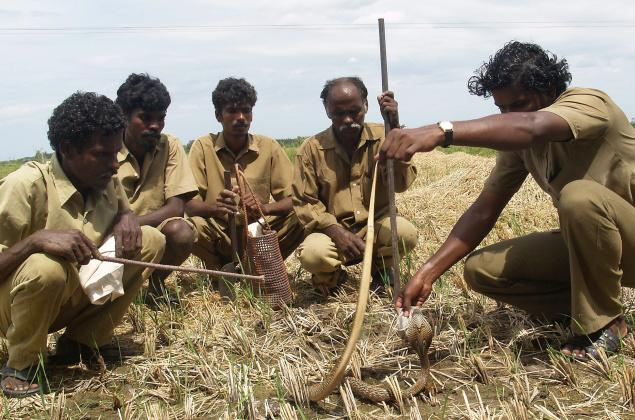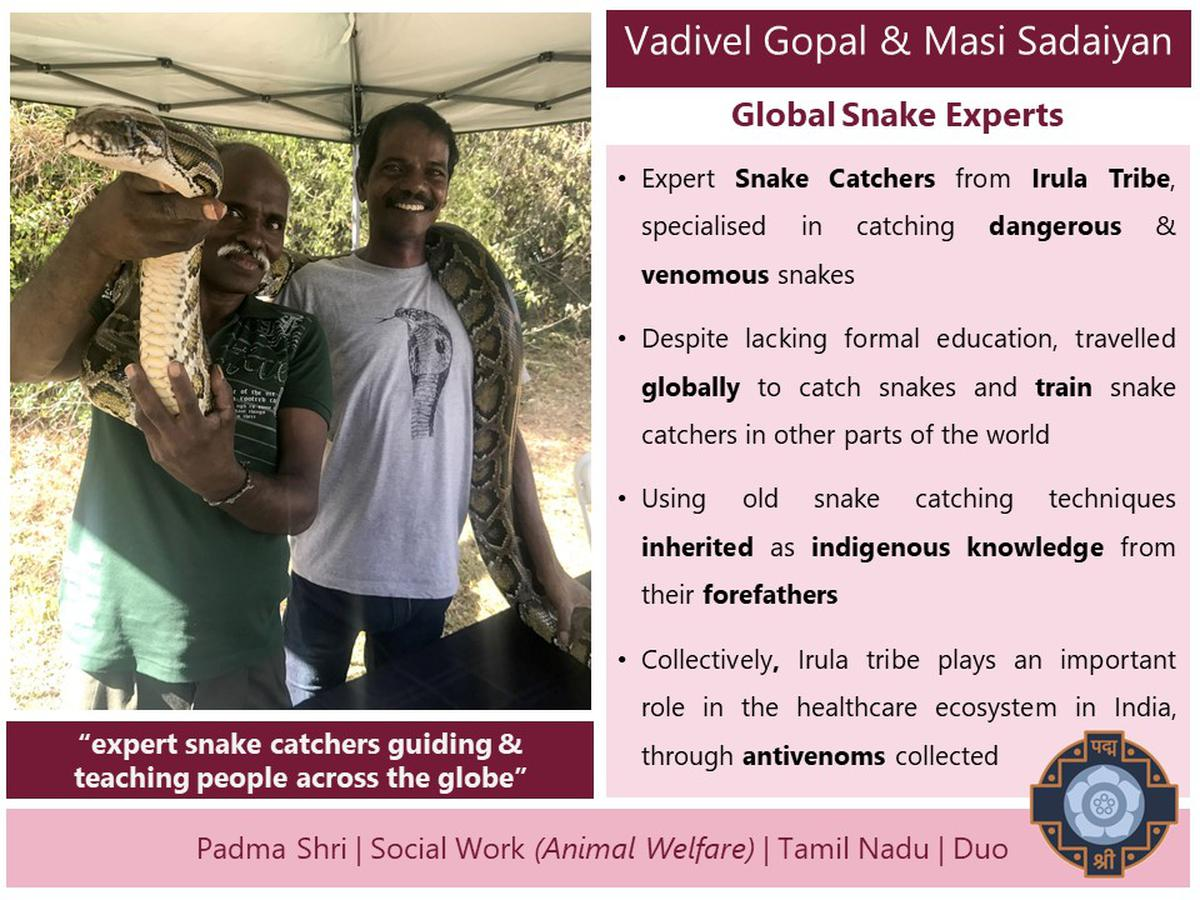Description

Copyright infringement not intended
In News
- Vadivel Gopal and Masi Sadaiyan of the Irula community received Padma Shri at a civil investiture ceremony at Rashtrapati Bhavan.
- Both are expert snake catchers and are members of the Irula Snake Catchers’ Industrial Cooperative Society, one of the major anti-snake venom (ASV) producers in India.
- In January 2017, Masi Sadaiyan and Vadivel Gopal were invited by the State of Florida (USA) to track down and capture invasive Burmese pythons. They captured 14 pythons in less than two weeks

Copyright infringement not intended
Irula Snake Catchers’ Industrial Cooperative Society
- In 1978, Romulus Whitaker (wildlife conservationist) established a venom centre in the form of a cooperative society with the help of a group of Irulas people.
- His vision was to turn Irulas’s traditional skills into sustainable employment-generating opportunities for the community through a cooperative society.
- The cooperative started with 11 Irulas members, and now has 350 members, including 160 women.
- Irulas people know the places where snakes hide, from experience and instinct and can find snakes by their track, smell and droppings.
- They treat snake bites with pachai elai marundhu, a herbal medicine, and avoid going to the hospital in most cases.
.jpeg)
Working Model of the Society:
- People from the Irulas community capture snakes from farmland, scrub forests, houses and lakes and bring them to society.
- The snakes are weighed, measured and checked for injuries by the cooperative members.
- Only snakes that pass the health check are used for venom extraction.
- Venom extraction exercises are done once a week, and after 28 days the snakes are released back into forests.
- After the extraction, the venom is then powdered and stored at a specific temperature to be sold to pharmaceutical companies.
- The society members are allowed by the government to catch snakes only between August and March.
Irulas Tribe:
- Irula tribe is a Dravidian ethnic group settling in the state of Tamil Nadu, Kerala and Karnataka.
- In the Tamil language, the Irula means "people of darkness." This could refer to their dark-coloured skin or since all important events of the tribe traditionally took place in the darkness/night.
- A study conducted by Yelmen et al (2019) found that the Irula people were the closest likely proxy for the indigenous Ancient Ancestral South Indian, one of the presumed founder and autochthonous original Indian populations.
- The DNA analysis (2018) of a skeleton from the Indus Valley Civilisation found in Rakhigarhi showed a greater association with the Irula people than any other modern ethnic group in India.
- According to the Census 2011, the tribe population is around 200,000;
- 189,621 in Tamil Nadu
- 23,721 in Kerala
- 10,259 in Karnataka.
- The people of the Irula tribe are called Irular and they speak the Irula language, which belongs to the Dravidian family.
- They are categorised under scheduled tribes.
- Irular believes in life after death.
- In general, the Irula are Hindu, but many of them have retained their own tribal beliefs that revolve around the spirit world.
- Traditionally, the main occupation of the Irulas has been snake, rat-catching and honey collection.
- They also work as labourers in the fields of the landlords during the sowing and harvesting seasons or in the rice mills.
- Fishing and cattle farming is also major occupation.
- Rats destroy a quarter of the grain grown on Tamil Nadu-area farms annually. To combat this pest, Irula men use a traditional earthen pot fumigation method.
- Their knowledge and use of herbal medicines, tracking and digging skills, and unusual diet (which includes rats) have been written about, filmed, studied and lauded.

Some unique Customs of the Irula Tribe:
- Generally, marriage is fixed for girls within the age limit of 12 -18 whereas boys' age is from 14-24. People from the same clan within the Irular tribe do not intermarry.
- Marriages are fixed within the family by the parents. Bride's prize has to be given to the girl's house in the form of cash or cattle.
- Marriages that do not have the acknowledgement of a local panchayat are considered invalid.
- During childbirth, a tent is erected near the pregnant woman's house. When the child is born nobody will go out of the tent and none will be allowed to enter the tent for seven days.
- On the 7th day, the child will be named during a big ceremony. The name will be the name of a grandfather or grandmother.
- For three months relatives other than the immediate parents, should not touch the child. During this period the mother will not do any work.
Tribal in India:
- The Term “Tribal” literally means ‘original inhabitants’ – are communities who lived and often continue to live, in close association with forests. They are very old Communities, being among the oldest inhabitants of the Sub-Continent.
- They are not a homogeneous population: there are over 500 different tribal groups in India.
- Their societies are also the most distinctive because there is often very little hierarchy among them. This makes them radically different from communities organised around principles of jati-varna (caste) or those that were ruled by kings.
- They practise a range of tribal religions that are different from Islam, Hinduism and Christianity. These often involve the worship of ancestors, village and nature spirits, the last associated with and residing in various sites in the landscape – ‘mountain spirits’, ‘river spirits’, ‘animal spirits’, etc.
- They have their languages (most of them radically different from and possibly as old as Sanskrit), which have often deeply influenced the formation of ‘mainstream’ Indian languages, like Bengali.
- Santhali has the largest number of speakers and has a significant body of publications including magazines on the internet.
- In terms of language, tribes are Categorized into 4 Categories:
- Indo-Aryan
- Dravidian
- Austric
- Tibeto-Burman
- In terms of size, the biggest tribes are Gonds, Bhils, Santhals, Oraons, Minas, Bodos and Mundas.
- The total population of tribes amounts to about 8.6% of the population of India.
- Based on livelihood, tribes Can be Categorized into Fishermen, food gatherers and hunters, Shifting Cultivators, Peasants, Plantation and industrial workers.
- Tribal Society is a more egalitarian and kinship-based mode of Social organization.
- Tribals were not always the oppressed groups they are now; there were Several Gond kingdoms in Central India.
- Many of the So-Called Rajput kingdoms of Central and western India emerged through a Process of Stratification among Adivasi Communities themselves.
- Adivasis often exercised dominance over the Plains People through their Capacity to raid them, and through their Services as local militias.
- They also occupied a Special trade niche, trading forest Produce, Salt and elephants.
- Capitalist economics to exploit forest resources and minerals to recruit cheap labour has brought tribal Societies into Contact with mainstream Society a long time ago.
- They were losing their land to non-tribal immigrant Settlers, and their access to forests because of the government policy of reservation of forests and the introduction of mining operations.
Challenges faced by Tribals:
- Land and forests were taken away from Tribal Societies in the name of development.
- Development involved the building of large dams, factories and mines. Because the tribal areas were located in mineral-rich and forest Covered Parts of the Country, tribals have paid a huge Price for the development of the rest of Indian Society. This kind of development has benefited the mainstream at the expense of the tribes.
- Forests Started to be systematically exploited in British times and the trend continued after Independence. The Coming of Private Property in the land has also adversely affected tribals, whose Community-based forms of Collective ownership were placed at a disadvantage in the new System.
- Many tribal Concentration regions and States have been experiencing the Problem of heavy in-migration of non-tribals. This threatens tribal Communities and Cultures, besides accelerating the Process of exploitation of tribals.
- In Tripura, the tribal Share of its Population halved within a Single decade, reducing them to a minority. Similar Pressure is being felt by Arunachal Pradesh.
- Many Tribals in the North-East States have been living for decades under Special laws that limit the Civil liberties of Citizens, States have been declared as ‘disturbed areas’.
- The vicious Circle of armed rebellions Provoking State repression which in turn fuels further rebellions has damaged the economy, Culture and Society of the North-eastern State.
Schemes for the development of Tribal:
- The Pre and Post Matric schemes are demand-based schemes and every ST student whose family income is up to Rs 2.5 lakhs is entitled to a scholarship for pursuing education from class IX to Post Doctorate across India.
- The states send the proposal for the estimated expenditure during the financial year based on the expenditure incurred in previous years and advance up to 50% of the Central share is released to the States.
- After the State has disbursed the scholarship to the students and has submitted certificates, the balance amount is released to the State provided the State has contributed its share.
- Pradhan Mantri Adi Adarsh Gram Yojna:
- Comprehensive development of 36,428 villages will be undertaken to develop these villages as Adarsh Gram, under ‘Pradhan Mantri Aadi Adarsh Gram Yojana’.
- These villages have a tribal population of more than 500 and are 50% tribal.
- Pradhan Mantri Janjatiya Vikas Mission
- The Mission seeks to achieve livelihood-driven tribal development in the next five years through the formation of Van Dhan groups that have been organized into Vandhan Kendras.
- New haats bazaar and warehouses will be developed in the next 5 years as part of “Atmanirbhar Bharat Abhyan”.
- TRIFED would be the nodal agency for implementing the scheme. The products produced will be marketed through Tribe India Stores.
- Venture Capital Fund for STs
- An amount of Rs. 50 cr. has been sanctioned for the new scheme of ‘Venture Capital Fund for Scheduled Tribes’ (VCF-ST), which is aimed at promoting Entrepreneurship among the STs.
- The VCF-ST scheme would be a social sector initiative to promote ST entrepreneurship and to support and incubate the start-up ideas of ST youth.
- Central Sector Scholarship Scheme for ST students was introduced in the academic year 2007-08 to encourage meritorious ST students for pursuing studies at the Degree and Postgraduate level in any of the Institutes identified by the Ministry of Tribal Affairs for the purpose.
- Vocational Training Centers in Tribal Areas
-
- The main aim of this scheme is to upgrade the skills of the tribal youth in various traditional/ modern vocations depending upon their educational qualification, present economic trends and the market potential, which would enable them to gain suitable employment or enable them to become self-employed.
https://www.thehindu.com/news/national/tamil-nadu/bravehearts-vadivel-and-sadaiyan-shine-a-light-for-irula-cooperative/article66464742.ece
Q. Consider the following statement about the Irula tribe.
-
- According to the Census 2011, the majority of the Irula people settled in Kerala.
- Irular believes in life after death.
- They are categorized under scheduled tribes.
Which of the following statement is/are correct?
(A)1 and 2 only
(B)2 and 3 only
(C)1 and 3 only
(D)1, 2 and 3
Answer: B
Explanation:
Statement 1 is incorrect: According to the Census 2011, the tribe population is around 200,000;
- 189,621 in Tamil Nadu
- 23,721 in Kerala
- 10,259 in Karnataka















